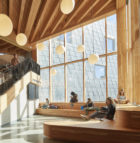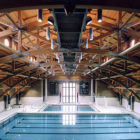A center for climate solutions
The New York Climate Exchange is the result of a bold initiative spearheaded by City of New York and The Trust for Governors Island—a vision to reimagine a treasured public space as a local and global hub for climate science. Working with anchor institution Stony Brook University, which will build the campus, SOM, MNLA, Buro Happold, and Langan Engineering are designing a living laboratory for sustainable research that will manifest the mission of The Exchange in its architecture, landscape, and infrastructure.

The Exchange will convene leaders from a variety of academic institutions, industry partners, and nonprofits to collaborate on climate research and deliver actionable solutions for restoring the health of the planet. For New Yorkers, it will also serve as the city’s main hub for green job training—preparing thousands of people for climate-focused professions every year.







